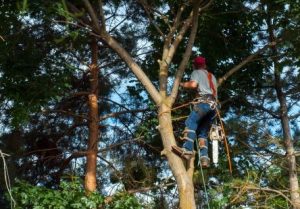
As the seasons change, so do the needs of our trees. Tree removal is a task that requires careful consideration and planning, regardless of the time of year. At Big Foot Tree Service, we understand the importance of proper tree removal techniques and the unique challenges that each season brings. In this blog post, we will share valuable tips and advice for seasonal tree removal to help you make informed decisions and ensure the health and safety of your property.

Spring
Spring is a season of renewal, and it’s an ideal time for tree removal projects. Here are a few tips for spring tree removal:
- Assess tree health: Inspect your trees for signs of disease, decay, or structural issues. Spring allows for better visibility of the tree’s overall condition due to the absence of leaves.
- Plan around nesting season: Before proceeding with tree removal, ensure that it won’t disturb nesting birds or other wildlife. Familiarize yourself with local regulations to protect wildlife habitats.
- Consider tree transplanting: If the tree is healthy but doesn’t fit your landscape, spring is a great time to consider tree transplanting instead of removal.
Summer:
Summer brings lush foliage and increased outdoor activities. Here’s what you should know about tree removal during this season:
- Be mindful of storm risks: Summer storms can cause significant damage to weakened or overgrown trees. Prioritize the removal of hazardous trees or limbs that pose a risk to your property or safety.
- Protect against pests: Look out for signs of insect infestations or diseases that thrive in warm weather. Prompt tree removal can prevent the spread of pests to other trees.
- Coordinate with professionals: Summer is a busy season for tree service companies, so it’s best to schedule your tree removal well in advance to secure their availability.
Fall:
Fall is renowned for its vibrant foliage, but it’s also a crucial time for tree removal. Consider the following tips for fall tree removal:
- Timing is essential: Schedule tree removal before the leaves start falling. Removing trees in fall can prevent leaf litter accumulation and facilitate a cleaner removal process.
- Prepare for winter storms: Weak or damaged trees can pose a significant risk during winter storms. Identify trees that need removal to prevent potential property damage or safety hazards during the colder months.
- Utilize fallen leaves: Instead of disposing of fallen leaves, consider composting or using them as mulch to enrich your garden.
Winter:
Winter might seem like an unconventional time for tree removal, but it has its advantages. Here’s what you should keep in mind:
- Assess tree structure: Winter’s leafless trees provide an unobstructed view of their overall structure. It’s an excellent time to identify any issues such as deadwood, weak branches, or signs of decay.
- Take advantage of dormant trees: The dormant season is ideal for certain tree removal projects, especially those involving large trees or invasive species.
- Plan for reforestation: If you decide to remove trees in winter, consider planning for tree replanting in the spring to maintain the environmental benefits and aesthetics of your property.
Tree removal is a task that requires careful consideration and adherence to seasonal factors. By following these seasonal tree removal tips from Big Foot Tree Service, you can ensure the health and safety of your property while contributing to the overall well-being of your landscape. Remember, it’s always best to consult with professionals who can provide expert advice tailored to your specific tree removal needs. Stay proactive, stay informed, and let Big Foot Tree Service be your trusted partner in all your seasonal tree removal endeavors.
Contact us today at 973-885-8000 or visit us online for more information about our seasonal tree removal services.









Recent Comments